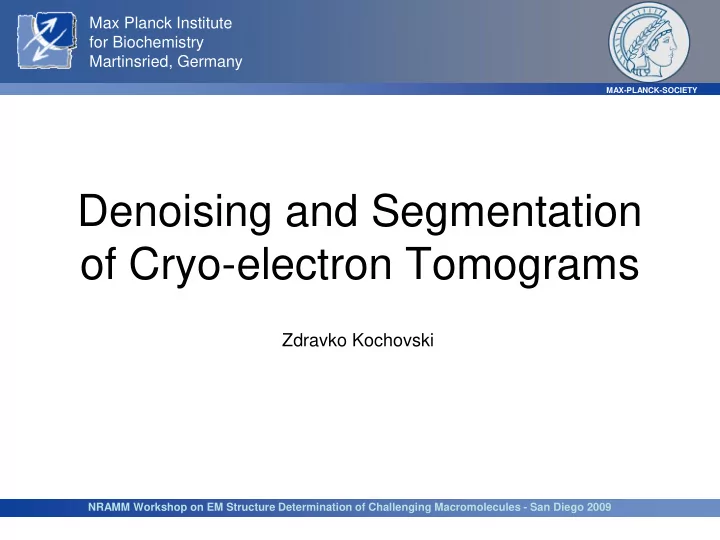

Max Planck Institute for Biochemistry Martinsried, Germany MAX-PLANCK-SOCIETY Denoising and Segmentation of Cryo-electron Tomograms Zdravko Kochovski NRAMM Workshop on EM Structure Determination of Challenging Macromolecules - San Diego 2009
Overview • Cryo-electron Tomography (Cryo-ET) • Image processing challenges in Cryo-ET • Denoising and segmentation - Denoising techniques - Segmentation techniques
Cryo-electron Tomography R. Fernández-Busnadiego, B. Zuber, U. Maurer, M. Cyrklaff, W. Baumeister and V. Lucic, in submission Cryo-electron Tomography of pinched-off nerve terminals (synaptosomes)
Image processing challenges in Cryo-ET Cryo-ET images represent a challenge for most of the current image and signal processing tools due to: • low signal-to-noise ratio (SNR) • the missing information (missing wedge) in Fourier space • the large number of structures observed in cryo- tomograms of cells and cellular compartments. • inaccuracies arising during 3D volume reconstruction • undetermined CTF
Denoising and segmentation Denoising - increase SNR and enhance features of interest in the tomograms Segmentation - extract the features of interest from the tomograms Data denoising and enhancement is often a critical step prior to segmentation !
Denoising techniques Linear vs. non-linear denoising techniques • linear filters remove the noise as well as the signal • non-linear filters reduce the noise and preserve features Real space vs. transform-based techniques • transform-based techniques are usually more complex and sometimes require immense computational efforts • real space techniques are relatively fast but not that good in preserving high-frequency spatial information
Denoising techniques Nonlinear anisotropic diffusion - NAD First implemented for cryo-ET by Frangakis and Hegerl JSB 2001 and later improved by Fernandez and Lee JSB 2003. Ordinary diffusion - diffusion flow from higher to lower concentration: Nonlinear anisotropic diffusion - diffusion different in different directions and for different pixels: • D: matrix that defines diffusion (can be different for every pixel) • R (rotation matrix): determines the direction of diffusion • λ's: determine magnitude of diffusion in the directions specified by R
Denoising techniques Nonlinear anisotropic diffusion - NAD Structure tensor - 3x3 matrix (tensor) that depends on the pixel position: Interpretation: • μ1 ≥ μ2 ≥ μ3: eigenvalues • v1, v2, v3: corresponding eigenvectors (mutually orthogonal) • v1, μ1: direction and magnitude of the maximum variance • v3, μ3: direction and magnitude of the minimum variance Fernandez and Lee JSB 2003 Useful quantities: • (pixel value) gradient: • coherence: Both indicate the existence of features!
Denoising techniques Nonlinear anisotropic diffusion - NAD Edge Enhancing Diffusion (EED) - edge preservation and edge enhancing: • Edge detection - edges defined as: • Parameter K defines edges (threshold-like): higher value - less edges (more denoising) value too low - noise interpreted as structure Coherence Enhancing Diffusion (CED) - improvement of flow-like structures (lines, planes): • Structure detection - structures defined as: • Parameter C defines structures
Denoising techniques Nonlinear anisotropic diffusion - NAD Hybrid CED / EED Approach Idea - the type of diffusion (CED or EED) is determined for each voxel - pure noise subtomogram used as a reference - several iterations EED or CED? - Pure noise subvolume used as a reference - threshold defined as the maximum coherence in the noise subvolume multiplied by the CED / EED balance parameter - local coherence larger then the threshold -> CED, otherwise EED Iterations - in the beginning more EED – smoothing with edge preservation - EED in the noise subvolume decreases coherence - lower CED / EED threshold induces more CED
Denoising techniques Non-local means algorithm - exploits image self similarity Discrete noisy image Non-local means filter The weights depend on the similarity between the pixels i and j The restored value of voxel x i (in red) is the weighted average of all intensities of voxels x j in the search volume V i , based on the similarity of their intensity neighborhoods u ( N i ) and u ( N j ). Source: Pierrick Coupé , et al. IJBI 2008 , Article ID 590183 (2008)
Segmentation Techniques Manual vs. Automatic segmentation Manual Segmentation: • prone to errors due to user bias • non-reproducibility • justifiable when applied to large, high contrast structures like membranes but questionable for smaller molecular structures • forces the user to evaluate the object of interest in 2D rather than in 3D • still continues to be the preferred method in electron tomography Automatic Segmentation: • reproducible • creates good results when the image complexity is low. • useful given the rapid increases in the rate of data acquisition Automatic segmentation techniques can be classified according to the method of operation : • region based vs. contour based • global vs. local.
Segmentation Techniques Thresholding & connectivity 1. Threshold cleft region at a given value, and select only the voxels with values below the threshold 2. Organize the groups of selected connected voxels into clusters 3. Retain only clusters connected to both synaptic membranes ( trans -cleft complexes) 4. Property of interest (lateral connectivity of complexes) was shown to be independent of threshold - not necessary to find an "optimal“ threshold Lucić et al. Structure 2005
Segmentation Techniques Watershed • Contour-based technique • Creates a boundary between objects that are separated by a valley that is deeper than a user-defined step size • Extensions: - marker-controlled watershed - hierarchical approach watershed Volkmann JSB 2002
Segmentation Techniques Combination of watershed and connectivity Segments that connect two synaptic vesicles (connectors) and a vesicle and the active zone (tethers) are detected at different thresholds. R. Fernández-Busnadiego, B. Zuber, U. Maurer, M. Cyrklaff, W. Baumeister and V. Lucic, in submission
Thank you! Acknoledgements: Max Planck Institute for Biochemistry Martinsried, Germany Ruben Fernandez Vladan Lucic Wolfgang Baumeister University of Almeria Spain José-Jesus Fernandez
Recommend
More recommend